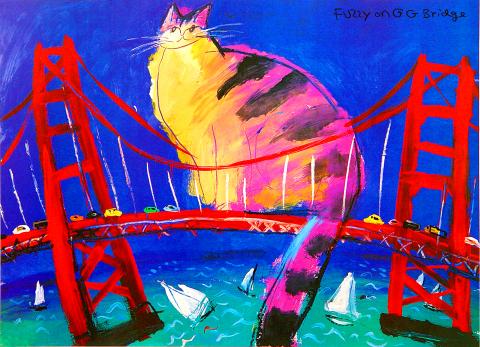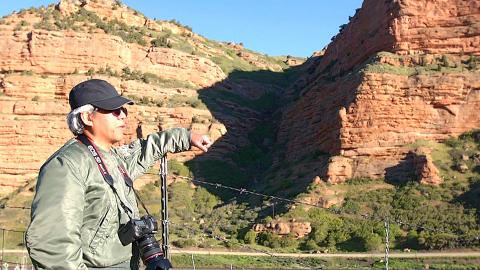An Odyssey of Dreams (童夢) starts off with a dark tone, as main subject Michael Leu (呂游銘) describes a recurring nightmare where he is being chased.
“I committed a serious crime, and they want to catch me,” he says, as he walks through a desolate landscape in the US, where Leu, a former interior designer and illustrator, emigrated to at age 33 to make it as an artist.
But much of the documentary, directed by Lai Chun-yu (賴俊羽), including the strings-and-piano driven soundtrack, is playful and whimsical, seemingly to match Leu’s personality and colorful art that mostly features cats of various sizes.

Photo courtesy of White Crane Films
Shot between 2011 and last year, there’s no clear timeline throughout the entire film as we can only vaguely detect which events happened in which order by the length of Leu’s hair. Within the first 20 minutes or so, we jump from Leu driving through the American West to him talking about his cat at his California home, then to his wife talking about how they met in Taiwan, and finally back on the road without clarifying whether it was the same road trip.
But this disorder does not detract from the film. Rather, it is more of an abstract but informational way of directing the audience’s attention on Leu as a person and not so much about the events that take place. The dialogue mostly takes the form of Leu’s stream-of-consciousness musings while he snaps photos of seagulls or sets up a booth at an art show, while we hear the more structured bits from other characters such as his family members and childhood friends.
From imitating a tiger’s roar to attract the attention of deer for a photograph, then analyzing the effectiveness of his action to simply describing a window in his house, Leu is always intriguing and endearing, and as a result the film has very few dull moments. It’s not all fun and games, though, as Leu also talks about his past, his work ethic, and his determination to make it in America.

Photo courtesy of atmovies.com
Another element that makes the format work is the transitions, as there is always a substantial set-up to a certain topic, often with bits that show more of Leu’s personality and life story. Some of these seem like devices to incorporate interesting but perhaps otherwise irrelevant shots into the film, but they help make the randomness less jarring. For example, there’s a long scene of Leu riding the subway in New York and snapping photographs in Times Square before we get to him visiting and interacting with his parents — and even that is a transitional device as then the camera turns to a family photo in the parents’ house, which leads the real topic at hand — Leu’s children.
The film’s tone changes about two-thirds into the film, as the audience probably has a good idea of who Leu is by then. The topics become more serious as Leu addresses his demons mentioned in the opening scene, and there is now a storyline going on as the scenes become longer and start following a chronological order.
At this point, the film starts featuring fantastic animations of Leu’s drawings and paintings to go with the narrative, which is director Lai’s forte as he was part of the team that won a Golden Horse for best visual effects with the 2007 film, Secret (不能說的秘密). It also starts employing a variety of fun effects such as adding a microphone echo to Leu’s voice when he recites a speech by his elementary school principal.
One may lament that Lai did not incorporate these flourishes earlier in the film, but since they are not Leu’s creations, perhaps they would have taken away from the sole focus on him and his work.

Most heroes are remembered for the battles they fought. Taiwan’s Black Bat Squadron is remembered for flying into Chinese airspace 838 times between 1953 and 1967, and for the 148 men whose sacrifice bought the intelligence that kept Taiwan secure. Two-thirds of the squadron died carrying out missions most people wouldn’t learn about for another 40 years. The squadron lost 15 aircraft and 148 crew members over those 14 years, making it the deadliest unit in Taiwan’s military history by casualty rate. They flew at night, often at low altitudes, straight into some of the most heavily defended airspace in Asia.

Taiwan’s democracy is at risk. Be very alarmed. This is not a drill. The current constitutional crisis progressed slowly, then suddenly. Political tensions, partisan hostility and emotions are all running high right when cool heads and calm negotiation are most needed. Oxford defines brinkmanship as: “The art or practice of pursuing a dangerous policy to the limits of safety before stopping, especially in politics.” It says the term comes from a quote from a 1956 Cold War interview with then-American Secretary of State John Foster Dulles, when he said: ‘The ability to get to the verge without getting into the war is

Like much in the world today, theater has experienced major disruptions over the six years since COVID-19. The pandemic, the war in Ukraine and social media have created a new normal of geopolitical and information uncertainty, and the performing arts are not immune to these effects. “Ten years ago people wanted to come to the theater to engage with important issues, but now the Internet allows them to engage with those issues powerfully and immediately,” said Faith Tan, programming director of the Esplanade in Singapore, speaking last week in Japan. “One reaction to unpredictability has been a renewed emphasis on

Beijing’s ironic, abusive tantrums aimed at Japan since Japanese Prime Minister Sanae Takaichi publicly stated that a Taiwan contingency would be an existential crisis for Japan, have revealed for all the world to see that the People’s Republic of China (PRC) lusts after Okinawa. We all owe Takaichi a debt of thanks for getting the PRC to make that public. The PRC and its netizens, taking their cue from the Chinese Communist Party (CCP), are presenting Okinawa by mirroring the claims about Taiwan. Official PRC propaganda organs began to wax lyrical about Okinawa’s “unsettled status” beginning last month. A Global